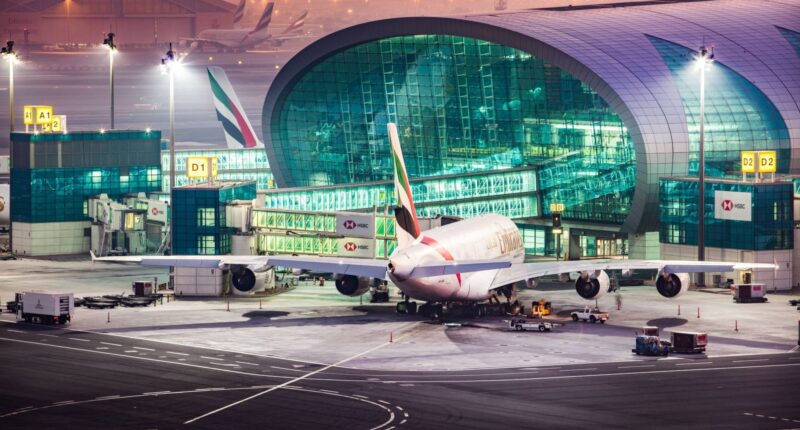You’re reading Entrepreneur Middle East, an international franchise of Entrepreneur Media.
In recent months, European airports have experienced various interferences ranging from scheduling to immigration delays. The new year’s travel spike saw Europe’s busiest airport, Heathrow, deal with a UK Border Force strike that caused vast disruption in its passport control. Similarly, Ireland’s Dublin airport has seen both a shortage of staff as well as drone activity contribute to widespread flight delays.
Things could not be more different for the Middle East’s travel sector. Dubai International Airport saw its passenger capacity reach 7.3 million passengers in March 2023, which is closest to the 7.8 million passengers it saw in January 2020, prior to the onset of the COVID-19 crisis.
But how did Dubai’s travel and aviation sectors manage to get itself back on track so quickly post-pandemic? The answer lies in Dubai’s prospering aviation industry, combined with its role as a global travel hub.
This can be seen from the first two months of 2023 alone, when the Emirate welcomed 3.1 million visitors. And that number is only set to rise in the future, according to the man in charge of Dubai’s tourism sector: Issam Kazim, CEO of Dubai’s Department of Economy and Tourism (DET).
 Issam Kazim, CEO of Dubai’s Department of Economy and Tourism. Source: DET
Issam Kazim, CEO of Dubai’s Department of Economy and Tourism. Source: DET
“As we look ahead, we expect the pillars of sustainability, gastronomy, trade and technology to play key roles in driving growth and catering to a diverse visitor profile,” Kazim told Entrepreneur Middle East. “With 2023 declared as the UAE’s ‘Year of Sustainability,’ this is indeed a landmark year for us, particularly as Dubai is preparing to host the 2023 edition of the United Nations Climate Change Conference (COP28). We will look at successfully balancing sustainability and destination strategies to incorporate sustainable practices into all aspects of the visitor experience, while also offering unique and compelling experiences to make Dubai the best city in the world to visit, live in, and work.”
Commenting on how Dubai became a first-choice destination for travellers following the impact of the COVID-19 pandemic, Kazim pointed toward the city’s leadership as being key to its revival. “It is without question that of all sectors, tourism and hospitality were the hardest hit, and the longest affected,” he said. “However, with the resolute support of our decisive leadership that inspired us to look at ways of transforming challenges into opportunities, Dubai was able to demonstrate a high level of resilience and foresight. Dubai was one of the first cities to close and go into a lockdown mode, then became one of the first to open and stay open. The UAE was also the single most vaccinated nation in the world, with over 97% of the total population fully vaccinated, leading to increased confidence in Dubai among domestic and international tourists.”
According to Kazim, there are three key lessons that he and his team at DET learnt as a result of the global pandemic. “The first is to remain resilient, be agile, and adapt to the changing landscape,” he explained. “This is how we were able to transform challenges into opportunities by successfully revitalising the domestic tourism market. The second is to restore travel confidence- this means providing clear and consistent information to travellers and businesses, ensuring health and safety protocols are in place and followed by residents and visitors.”
The third lesson, Kazim continued, was centred on instilling travel confidence, which he noted to be an important way of communicating and collaborating with stakeholders and partners. DET did this by providing them with industry updates that could help them secure financial assistance, which, in turn, helped businesses cope with the impact of the pandemic. The CEO also emphasized the significance of building more resilient and sustainable tourism- this involved taking advantage of the opportunity to rethink future tourism, addressing its social, environmental, and economic impacts, while ensuring it contributes to inclusive development.
Kazim also pointed toward Dubai’s aviation sector as being a key enabler of the resurgence of the city’s tourism industry. “Dubai’s Department of Economy and Tourism works very closely with our partners in the aviation sector to promote and support growth of tourism in the city,” he said. “The aviation sector plays a crucial role in connecting Dubai with the rest of the world, and facilitating the influx of tourists and visitors. In the true spirit of collaboration, the aviation sector continues to contribute tremendously to the city’s success.”
Eugene Barry is the Chief Commercial Officer at Dubai Airports, the body that manages Dubai’s two international airports, Dubai International Airport (DXB) and Al Maktoum International Airport (DWC). As he looked back at how his institution fared through the course of the COVID-19 crisis, Barry noted how it helped to have its priorities clearly defined during that period. “Dubai Airports’ primary consideration at this point was the health and welfare of our employees, our partners, and our customers during what was a fast evolving and uncertain situation,” Barry recalled. “Nevertheless, in parallel, immediate steps have been taken to safeguard our business partnerships, contractually and practically speaking, to ensure that all our partners on both the aviation and (e.g. airlines, ground handler, fuel companies) and the non-aviation sides (e.g. consumer-facing) were afforded the necessary degree of clarity and tangible support from Dubai Airports.”
 Eugene Barry, Chief Commercial Officer at Dubai Airports. Source: Dubai Airports
Eugene Barry, Chief Commercial Officer at Dubai Airports. Source: Dubai Airports
“This was necessary to ensure that core airport activities remained operational to support repatriation flights and cargo operations, both of which continued uninterrupted at DXB,” Barry continued. “However, while international borders remained closed for a 45 day period, a longer-term revenue strategy was quickly developed and deployed to support over 1,000 business partnerships equitably, and ensure that they remained fully resourced for the eventual reactivation of all DXB terminals once international travel started to reopen and recover.”
Barry goes on to say that Dubai Airports’ success in managing the international travel rebound can be attributed to how the crisis was initially addressed. The foundations of the business base were protected and even strengthened during this time, and so, when international borders reopened, Dubai Airports and its partners were quick to mobilize to meet all of their customers’ expectations. Indeed, when travellers came through DXB again in growing numbers in the latter part of 2020, they saw an airport that was fully resourced.
During the course of the pandemic, Emirates SkyCargo, the cargo arm of Dubai’s Emirates Airline, much like most other organizations in that period, experienced a number of challenges in adjusting to a new world of commerce. One of these was meeting worldwide demand reliant on imports for food security, and Emirates SkyCargo tackled it by repurposing their ground passenger fleet, incorporating 19 modified Boeing 777-300ER passenger aircrafts with seats removed from their economy class cabins and thereby unlocking 17 tonnes of cargo capacity for every flight.
 Nabil Sultan, CEO of Emirates SkyCargo. Source: Emirates
Nabil Sultan, CEO of Emirates SkyCargo. Source: Emirates
Now, though, in a positive turn of events, Emirates SkyCargo is set to double its capacity over the next decade. In fact, it announced in May this year that it had added two new Boeing 747-F leases to its fleet, which would add immediate capacity as well as signal confidence in the global cargo market. Of course, this is a massive shift from what the situation that the company was facing as the COVID-19 pandemic was raging, Emirates SkyCargo CEO Nabil Sultan told Entrepreneur Middle East.
“From the beginning of the pandemic, Emirates SkyCargo had the responsibility of connecting people and businesses across the world with the commodities that they urgently needed,” Sultan explained. “By pivoting quickly, with our innovative and resilient spirit, Emirates SkyCargo served as a global conveyor belt, during these difficult times. Restoring our network, while navigating the evolving and complex landscape, was an ongoing challenge that we worked through with all aviation stakeholders. By May 2020, we had reconnected six continents with scheduled cargo flights to 75 global destinations, and, two months later in July 2020, we increased our network to 100 destinations, and hit the milestone of 10,000 cargo flights in just three months.”
The COVID-19 crisis has also led to new opportunities (and challenges) for the global air cargo sector, Sultan noted. “Demand for e-commerce, already on an upward trend, was further accelerated by the pandemic,” he pointed out. “Given the speed of fulfillment that consumers expect, demand for air transport will increase, with the International Air Transport Association (IATA ) estimating that e-commerce purchases already account for between 18 and 20% of air freight. We are exploring ways to facilitate this demand. For example, in 2019 Emirates SkyCargo launched Emirates Delivers, an end-to-end solution that connects UAE-based consumers with e-commerce retailers in the US and the UK that do not offer international delivery.”
Over the next ten years, Emirates SkyCargo expects to add over 20 new destinations to its freighter network, and offer even more flexibility to its customer base. With streamlined and efficient operations, its cargo terminals in Dubai possess the ability to offer transit times of as little as three hours air-to-air. The central location of the city also gives the company geographic advantage, enabling it to reach 2.5 billion people within four hours of flight.
It thus seems safe to say that the future of the aviation sector in the UAE and the wider region looks to be a prosperous one. In fact, the Marathon Oil Corp (MRO) has projected positive growth on the part of Middle Eastern aviation, with the region’s fleet set to expand 5.1% annually over the next decade. Additionally the region’s share of the global fleet will grow over the next ten years from 4.9% in 2023, to 6% in 2033- all of which signals a bright future indeed.
This article is from Entrepreneur.com








